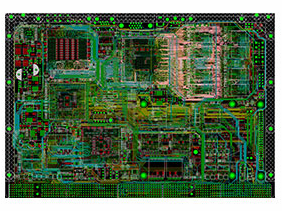AOI (Auto Optical Inspection) is an optical identification system. It is now widely used in the PCB assembly line of the PCB industry to replace the previous manual visual inspection operations. It uses imaging technology to determine whether there is a difference between the object to be tested and the standard image. Whether the test object meets the standard. In the early days, it was mostly used to detect defects in the surface printing after IC (integrated circuit) packaging. With the evolution of technology, it is now used to detect PCB assembly on SMT assembly lines. The quality of the solder paste, or check whether the solder paste meets the standard after printing.
AOI equipment diagram
The biggest advantage of AOI is that it can replace the previous manual visual inspection work before and after the SMT furnace, and it can judge the shortcomings of SMT parts and assembly more accurately than the human eye. But just like the human eye, AOI can basically only perform surface inspection of the object, so as long as it is a shape that can be seen on the surface of the object, it can be checked correctly, but for hidden under the part or the edge of the part The solder joints may be a bit weak. Of course, many AOIs can already perform multi-angle photography to increase their ability to detect IC pin tilt, and increase the camera angle of some masked components. Provides more detection rate, but the effect is always not ideal, and it is difficult to achieve 100% coverage.

In fact, the biggest disadvantage of AOI is that some gray scales or shadows are not very obvious, and it is easier to have false rejects. These may be distinguished by different colors of lights, but the most troublesome The components that are covered by other parts and the solder joints located under the components, because the traditional AOI can only detect the places that can be reached by direct light, such as the ribs of the shield frame or the components under the edges, often because of AOI It was undetectable and missed the past.
Therefore, the general circuit board assembly production line rarely only uses AOI to ensure its assembly quality. It usually has to go through ICT (In-Circuit Test) and functional testing. Some production lines will add an AXI (Auto-Xray-Inspection ), use X-Ray to check the quality of the solder joints (such as BGA) under the components along the line.
As far as I know, the current AOI should be able to fully check out the following shortcomings, and most of these shortcomings can be detected without errors during manual visual inspection:
Missing (Missing)
AOI_Missing missing parts
Skew (Skew)
AOI_skew skew
Tomestone
AOI_tombstone tombstone
In addition, because optical inspection is subject to factors such as light, angle, resolution, etc., the following shortcomings can only be detected under certain conditions, but it is difficult to achieve a 100% detection rate, that is to say :
Wrong component: If it is a wrong component with a different shape, or a part with a different printing on the surface, AOI should also be able to check it out. But if the appearance is not significantly different, and there is no surface printing, such as resistors and capacitors below 0402 size, these are difficult to detect with AOI.
Wrong polarity: This must also depend on whether the part itself has a symbol indicating the polarity of the part, or the difference in appearance and shape can be performed.
Lead lift, lead defective:
Severe foot curling can be judged by the difference in the brightness of light reflections, but slight foot curling can be somewhat difficult. Severe foot deformation can also be easily detected by using AOI. Slight foot upturning is closed depending on the situation, which usually depends on the strictness of the parameter adjustment, and more depends on the experience value of the engineer or operator.
AOI_Lifted_lead foot lifted AOI_Lead_Defective foot deformed
Solder bridge:
Generally speaking, the tin bridge is easy to check, but if it is a tin bridge hidden under the part, it cannot be done. For example, the tin bridges of some connectors are all located at the bottom of the component body. At this time, there is no way to detect it using AOI.
AOI_solder_bridge tin bridge
Insufficient solder:
When the amount of tin is seriously insufficient, of course, you can use AOI to easily judge, but there will always be some errors in the amount of solder paste printed. At this time, you need to collect a certain number of products to determine the amount.
AOI_insufficient_solder Shao Xi
False welding and cold welding: This is the most annoying problem, because it is usually difficult to detect false or cold welding from the outside. Even if it can be judged by its appearance and shape, the difference is really very small. Adjust the parameters. Too strict is easy to misjudge. Problems like this always need to be adjusted for a period of time to get the best parameters.
In short, although AOI is easy to use, it does have some inherent limitations on PCB testing. However, it is used for real-time PCB preliminary quality analysis, and immediately feedback the quality of SMT, and improve it, which can indeed effectively increase the yield of PCB. . Generally, it is already 24 hours after the problem is caught by the ICT test machine and the PCB is reacted to the PCB. The PCB condition at that time has usually changed, and even the line has been changed. Therefore, from the perspective of quality control, AOI does have its existence.